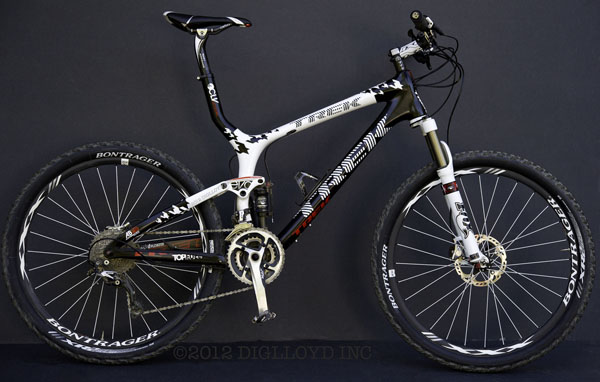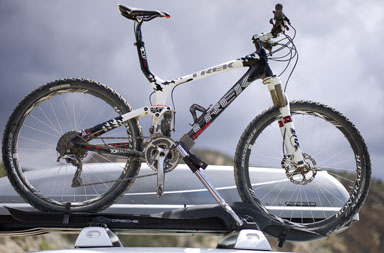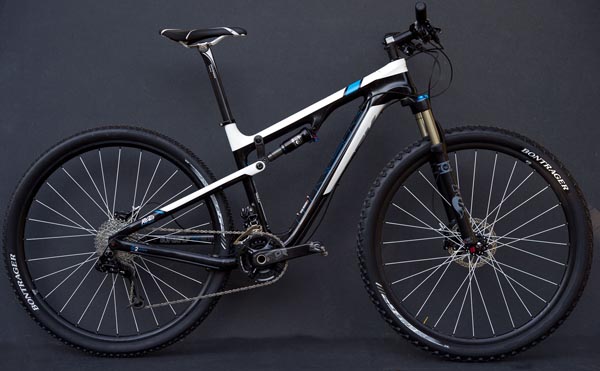White Mountain Peak MTB — Bike Evaluation
Related: hard core, Inyo National Forest, Moots, mountain biking, noise, peak bagging, Rides, Shimano, Silver Canyon, White Mountain Peak, White Mountains
For the 2011 Trek to the Summit of White Mountain Peak, Trek Bicycles loaned us two of their top of the line mountain bikes, the Trek Top Fuel 9.9 SSL and the 29er Trek 'Gary Fisher' SuperFly 100 Elite.
Besides the all-day epic ride for its own sake, a goal of the trip was to evaluate these two top-of-the-line Trek mountain bikes, one a classic race-oriented 26" bike, and the other a race-ready 29er, both carbon fiber, and both with dual suspension.
These are both terrific bikes, but I’m going to point out every single detail I can, so that prospective buyers can be clear on the strengths, limitations and differences of the two bikes.
Tire change
Because the Silver Canyon and White Mountain Road are rocky and loose, I installed Bontrager tubeless tires on both bikes (with Stan’s sealant), for both comfort and grip. This turned out to be an excellent choice.
For unknown reasons, the SuperFly 100 Elite showed up with a Bontrager Team Issue 2.25" front tire and 2.0" rear tire. The Trek web site specifies 2.1" tires both front and rear. With experience now, I would prefer to run 2.25" front and rear.
Evaluating the bikes
The two bikes were swapped several times by the two riders along the route, for two perspectives. Comments also reflect observations from local 2-3 hour rides on hard pack singletrack trails and some fire-road and even a little pavement riding.
The Trek to the Summit of White Mountain Peak is an epic all-day ride, and not necessarily the type of riding for which either bike is designed, especially the Top Fuel 9.9 SSL. The Top Fuel 9.9 SSL is an ultralight race-oriented bike for short cross-country courses, though it’s also a pleasure for extended general cross country use.
The long and ultra-steep descent of upper Silver Canyon is an extreme case (grade up to 30%), and thus unlikely to be encountered by most riders or during most rides. At the end of our epic ride, we descended upper Silver Canyon with its average grade of 17%, and a portion of lower Silver Canyon to return to our campsite (having descended the remainder to begin the day).
| Evaluation Item | Trek Top Fuel 9.9 SSL | Trek Gary Fisher SuperFly 100 Elite |
|---|---|---|
| Gearing | Set up as a race bike, not ideal for steep climbs with 30 chainring; should have 28 X 40 instead of 30 X 42 chainrings.* | Even accounting for 29" wheels, the 26 -tooth small ring X 36-tooth rear offers slightly easier climbing than the 30 X 36 of the Top Fuel. |
| Climbing | Excellent, and 2+ pounds lighter. Nice remote lockout mechanism for rear shock on smoother stuff. | Excellent, but easier and less effort over loose rocks due to 29" wheels, but stock 2.0" rear tire would sometimes slip. |
| Descending | Less stable at speed (26" wheels, shorter wheelbase), much more attention required to technical sections. | Less technical skill needed on both fast fire road descents and especially good when the going gets rough (29" wheels roll over loose stuff and rocks more easily, maintain momentum). |
| Steering** | Not as precise as one might like on a line, becomes uncertain under rough technical conditions and hard cornering forces, harder to keep on line, all of which results in a loss of confidence at “the edge”. This might be due to the 9mm front axle. | Also has 9mm front axle, but, the flanges on the front fork of the SuperFly appear to be larger diameter and beefier, and this no doubt improves the stability of the 9mm axle. Also, the 29" wheels seemed to compensate and make steering easier than the Top Fuel both on the rough stuff but also on sweeper turns. |
| Shock lockout | Front and rear remote lockouts that are easy to operate even when pounding down the rough stuff— superb. | One must reach with hand to manually lock out shocks. This is a serious handicap in some riding conditions; because it can only be done when one hand is sufficient on the handlebar, and it’s a distraction reaching down or forward— not a good idea when bouncing around in rough conditions, so one must always anticipate.. |
| Brakes | Superb. No brake fade or noise with Shimano XTR: 160mm front rotor, metallic pads with heat sinks | Inferior brakes (Avid XO with 160mm rotors, apparent metallic pads) showed a loss of braking power down upper Silver Canyon (severe downhill grade up to 30% requiring constant braking). Forced to stop for cooling, brakes front and rear made a great deal of noise which persisted even after the descent. Brake pads 'toast' after descent, replacement required. |
| Comfort | Very good, but less comfortable seat and ride compared to SuperFly 100 Elite, bouncier more jarring ride. | Outstanding with excellent seat and large 29" wheels smoothing out the ride and bumps. |
| Smooth surface riding | Excellent (when rear lockout works properly) | Excellent |
| Overall feel | One’s body is over the whole bike, tight, fast, nimble, agile. Classic 26" race bike. | One is in a cockpit with bike front and rear, not as quick and nimble, does not sprint fast (29" wheels, longer wheelbase). |
| Riding over rough stuff | Requires considerable concentration over fist-size rocks, bounces around much more than SuperFly, simply much less stable with 26" wheels than 29" wheels. | 29" wheels roll over the rough stuff and require much less attention on rough stuff, when cornering wide sweeping turns, etc |
| Fast descents | Requires concentration due to short wheelbase and nimble steering | Wheel momentum of 29" wheels and the longer wheelbase make the ride very stable and confidence inspiring. |
| Wheels | Carbon fiber wheels | Scandium wheels. |
* Trek apparently offers no customization for the crankset chainrings, but perhaps a cooperative local dealer might be able to swap a brand-new crankset out for a new bike. For really steep stuff a 26 X 38 setup (on 26"), or a triple chainring might be preferable.
** 15QR front axle strangely absent
Use of a 15QR front axle on both bikes might help with the steering precision (but 15QR is not an option on either bike). My Moots YBB experience suggests that 15QR is a factor in nailing down the steering precision. Since both Trek bikes have apparently stiff and responsive frames, they should respond well with a 15QR front axle (which means a new front shock and a 15QR wheel).
Since Trek’s Fuel EX uses a 15QR axle, it’s puzzling why Trek opted for a 9mm axle on the Top Fuel 9.9 SSL. But Trek's 2011 feature table (see page 165) for the race-oriented bikes does not even list 15QR as a feature, so it’s clear it was a deliberate decision.
But the above is all speculation— the lack of front-end precision I feel on the Top Fuel 9.9 SSL might be 15QR, but it also might be that the front half of the bike just has enough “give” for the goal of weight savings to have reduced the front-end rigidity. And/or that the wheelset contributes some flex. It’s impossible to say without isolating components on identical bikes.
The SuperFly Elite 100, even though it also has a 9mm axle, did not seem to be affected the same way, but the longer wheelbase and larger wheels are mitigating factors that mask steering variation, so I suspect that handling on the SuperFly would also improve with a 15QR front axle.
Other observations
Practical stuff.
| Evaluation Item | Trek Top Fuel 9.9 SSL 17.5" | Trek Gary Fisher SuperFly 100 Elite 17.5" |
|---|---|---|
| Bike repair stand | Cannot fit in my bike stand; top tube is too wide. | Cannot fit in my bike stand, rear shock is in the way. |
| Water bottles | Very tight fit. | Very tight fit, can lock or unlock the rear shock lockout lever when inserting or removing full-size bottle. |
| Car rooftop rack | Fits in bike rack on car rooftop (use padding). Most bike racks with a bottom tube clamp warn against clamping carbon frames, but I wrapped the bottom tube with 3/8" closed cell foam and used appropriate force with zero trouble. Also, Trek’s OCLV Mountain frame should have the requisite strength— just be careful with clamping forces. |
Tube too large in diameter to fit in bike rack. I was forced to remove the front wheel and carry the SuperFly in my SUV. It fit— barely. As a practical matter, a 29er is problematic for smaller vehicles unless one can obtain a suitable rooftop rack— the wheels are substantially larger. |
| Rock guard on bottom tube | No rock guard. Unclear if this would be an issue long term with rocks banging into bottom tube, but Trek’s OCLV Mountain carbon fiber is allegedly very rock resistant. | Plastic rock guard to protect bottom tube |
| Seat post clamp | Requires allen wrench to modify seat height (pretty much standard fare these days for a race bike). Allen socket that does not provide robust fit for allen wrench, loose fit 4mm allen. Ultimately had to compromise by choosing one seat height that was slightly lower than ideal for flat/ascending, and slightly higher than desirable for descending. SuperFly clamp was prone to coming loose off the seat tube, and had to be reseated. |
|
Personal favorite
My personal favorite for the Trek to the Summit of White Mountain Peak was the Trek Gary Fisher SuperFly 100 Elite. The SuperFly 100 Elite climbed about as well as the Top Fuel 9.9 SSL (except for some loose stuff where a larger rear tire would have been better), and it made riding over the rough stuff easier. I could relax more, and I could “clean” technical sections more easily. I attribute that to the 29" wheels.
However, the SuperFly 100 Elite brakes I deem marginal for my weight for this type of riding compared to the Top Fuel Shimano XTR brakes, and that’s a problem, since the brakes are a critical component. While everyday riding is not so extreme, still, given the large investment, I would be reluctant to pony up for the Avid components, just because of the brakes, which in my view are an unacceptable point of compromise— I do not want to have to stop and let brakes cool, or to have severe brake noise, as I did descending the 17% grade of upper Silver Canyon. Trek might consider offering the SuperFly with Shimano XTR as an alternative, as the should be moderate in percentage terms when considering the overall price.
Up to 64TB @ 12500 MB/sec!
Mac or PC.
Ideal for Lightroom, Photoshop, 8K video, data analysis, etc.
Trek Top Fuel 9.9 SSL (2011)
The Top Fuel 9.9 SSL weighs in at 22.9 pounds with Shimano XT pedals and one carbon water bottle cage (as actually weighed). Weight with tubeless setup using Bontrager XR2 26 X 2.1" Team Issue tires and Stan’s sealant.
The Top Fuel 9.9 SSL has a ~2.5-pound weight advantage over the SuperFly 100 Elite when tire widths and pedals (XTR vs XT) are equalized to be comparable.
Like the SuperFly 100 Elite, the 2011 Top Fuel 9.9 SSL uses a standard skewer, not 15QR, and this is inferior to 15QR for front-end stability based on my experience with 15QR on my Moots YBB. Lighter riders might not care, but at 170 pounds (and occassionally 195 with a pack), I want a supremely solid front-end.

Why settle for anything less than the best tech, best looks, and best performance?
The Top Fuel 9.9 SSL fit in my bike rack (carefully padded with closed-cell foam and clamped near the bottom). The SuperFly 100 Elite has too large a diameter bottom tube, so it had to go inside the vehicle, a practical nuisance.

Trek SuperFly 100 Elite
The Trek SuperFly 100 Elite 29er roll over the rough stuff with ease, due to its 29" wheels.
The SuperFly 100 Elite weighs in at 25.1 pounds with Shimano XTR pedals and one carbon water bottle cage (as actually weighed). Weight with tubeless setup using Bontrager 29er Team Issue 29 X 2.25" front tire and a narrower 29 X 2.0" Team Issue tire with Stan’s sealant.
To compare fairly to the Top Fuel 9.9 SSL weight quoted above, one must equalize the pedals(XTR has a 40g advantage), and tires; the supplied SuperFly rear tire is too narrow for loose terrain and really should also be a 2.25" tire that matches the front tire. So it is fair to quote the SuperFly as something closer to 2.5 pounds heavier than the Top Fuel 9.9 SSL.
Same comments on 15QR as with the Top Fuel 9.9 above, except that the 29" wheels seem to mitigate the handling issue.




